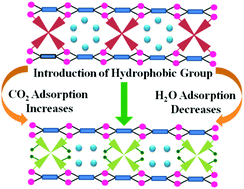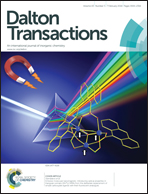Porous coordination polymers based on functionalized Schiff base linkers: enhanced CO2 uptake by pore surface modification†
Abstract
We report the synthesis, structural characterization and adsorption properties of three new porous coordination polymers {[Cu(Meazpy)0.5(glut)](H2O)}n (2), {[Zn(azpy)0.5(terep)](H2O)}n (3), and {[Zn(Meazpy)0.5(terep)]}n (4) [glut = glutarate, terep = terephthalate, azpy = N,N′-bis-(pyridin-4-ylmethylene)hydrazine and Meazpy = N,N′-bis-(1-pyridin-4-ylethylidene)hydrazine] composed of mixed linkers systems. Structure determination reveals that all three compounds have three-dimensional (3D) coordination frameworks bridged by dicarboxylates and Schiff base linkers. In all cases 2D dicarboxylate layers are supported by paddle-wheel M2(CO2)4 SBUs extended in three dimensions by designed Schiff base linkers. Compound 1, which has been reported in a paper earlier by our group, is a robust porous three-dimensional (3D) framework whose pore surface was found to be decorated with the –CH![[double bond, length as m-dash]](https://www.rsc.org/images/entities/char_e001.gif) N– groups of a linear Schiff base (azpy) and it showed reversible single-crystal-to-single-crystal transformation and selective CO2 uptake. By using another linear Schiff base linker Meazpy, we have synthesized compound 2 which is isostructural with 1, having an additional methyl group pointing towards the pore. Like 1 it also shows a reversible single-crystal-to-single-crystal transformation upon dehydration and rehydration. The dehydrated framework of 2 exhibits 50% enhanced CO2 uptake compared to 1. This has been achieved by the pore surface modification effected upon changing the pillar backbone from a –CH
N– groups of a linear Schiff base (azpy) and it showed reversible single-crystal-to-single-crystal transformation and selective CO2 uptake. By using another linear Schiff base linker Meazpy, we have synthesized compound 2 which is isostructural with 1, having an additional methyl group pointing towards the pore. Like 1 it also shows a reversible single-crystal-to-single-crystal transformation upon dehydration and rehydration. The dehydrated framework of 2 exhibits 50% enhanced CO2 uptake compared to 1. This has been achieved by the pore surface modification effected upon changing the pillar backbone from a –CH![[double bond, length as m-dash]](https://www.rsc.org/images/entities/char_e001.gif) N– to –CMe
N– to –CMe![[double bond, length as m-dash]](https://www.rsc.org/images/entities/char_e001.gif) N– group. It also adsorbs water vapour at 298 K. In the case of the two isostructural 3D MOFs 3 and 4, the use of a rigid carboxylate (terephthalate) linker arrested porosity by three-fold interpenetration. We showed that the use of aliphatic dicarboxylate (glutarate) results in a non-interpenetrated framework rather than the common interpenetrated framework with aromatic dicarboxylates in mixed ligand systems.
N– group. It also adsorbs water vapour at 298 K. In the case of the two isostructural 3D MOFs 3 and 4, the use of a rigid carboxylate (terephthalate) linker arrested porosity by three-fold interpenetration. We showed that the use of aliphatic dicarboxylate (glutarate) results in a non-interpenetrated framework rather than the common interpenetrated framework with aromatic dicarboxylates in mixed ligand systems.


 Please wait while we load your content...
Please wait while we load your content...